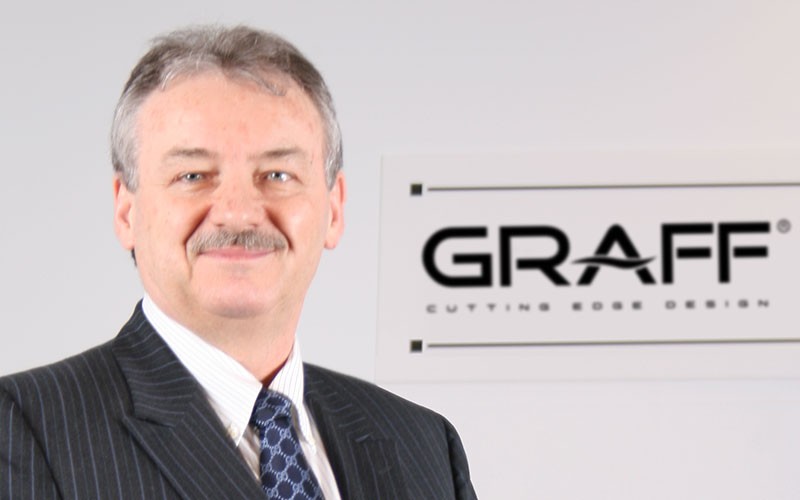Year of publication
Media / Media spotlights
Media spotlights
05/30/2015
Q&A with Kitchen and Bath Leader on Plumbing Fixtures | Plumbing Engineer
The Decorative Plumbing & Hardware Association (DPHA) was founded in 2002 to serve as a cutting-edge nonprofit organization that creates competitive advantages for its members by advancing the business and professional development of independent dealers, manufacturers, representatives and others involved in the decorative plumbing and hardware industry. Today, DPHA employs a unique consensus-based approach to serve nearly 400 members by treating showrooms manufacturers and manufacturer’s representatives as peers and partners.
The association’s reputation for quality and the ability to create value for its members has enabled DPHA to become one of the largest associations in the U.S. dedicated exclusively to the interests of the independent decorative plumbing and hardware channel. GRAFF, an international manufacturer of bathroom and kitchen fixtures, has been a member of DPHA since 2005. Ziggy Kulig, president and CEO of the company, is one of the nine representatives of DPHA Manufacturer’s Council. The council helps strategize for the annual DPHA Conference and Product Showcase, making sure that the events are effective for the dealers, manufacturers, representatives and industry professionals that attend.
Following is what Kulig has been hearing in conversations about plumbing fixtures as the association prepares for the conference, which is coming up in October.
Q: Can you talk a little about your professional career?
A: In the 70s, I began my career in Milwaukee, Wis., manufacturing products for the automotive industry. Throughout the next decade, a parent company for that business was established, Meridian International Group, and I added a manufacturing facility in Europe. GRAFF, a division of Meridian International Group, is headquartered in Milwaukee, Wis., and with locations throughout Europe is recognized globally for its trend-setting products and unique vision. Supported by extensive plumbing and hardware manufacturing experience, GRAFF offers a wide range of contemporary, transitional and traditional styling.
Q: Can you talk about your involvement with DPHA?
A: GRAFF has been involved with the DPHA since 2005, participating and sponsoring their organization and their valuable conferences and events. We consider our partnership with the DPHA to be an essential part of our overall corporate strategy for success. They provide our entire organization with resources, timely educational tools, and helpful technical information. We’re proud to be affiliated and aligned with the DPHA and will continue to support them in their mission to create a competitive advantage for their members.
Q: What is the “buzz” when it comes to plumbing fixtures?
A: Water conservation. With water being such a precious asset, especially in certain places in the U.S., it’s crucial that we all do our part in conserving water. The new CALGreen standards set forth in California are helping to set the standard for the entire U.S. CALGreen minimum standards put in place sensible green practices to incorporate environmentally responsible construction measures into the everyday building in California. Our company has been embracing these water-use standards and integrating them into innovative faucets, handshowers and showerhead designs. CALGreen is an integral step in designing green buildings and reducing the carbon footprint houses and buildings have on the environment.
Q: How should the industry be addressing water conservation when it comes to plumbing fixtures?
A: Not only do products need to be created in a way that respects water conservation technologies, but they also must be designed to create a soothing, spa-like relaxing atmosphere right in the home. The bath space has now gone through a transition and become a place where people actually spend time to rejuvenate their mind, body and soul, exuding an overall sense of well-being. Bath spaces need to be created as a private wellness center that pampers the user to the fullest, personally designed to evoke a totally tranquil and luxurious experience.
Q: What are some of the trends you have noticed with plumbing fixtures?
A: As in any other striking focal point in architecture or interior design, bath and kitchen design is trending toward fixtures that culminate in artist forms, considering new design approaches to color, shape and style. An individual’s bath or kitchen space says as much about the owner’s personality as it does about their sense of style. Polished Chrome and Brushed Nickel are the most popular finishes when it comes to bath and kitchen fixture hardware. However, a strong trend toward architectural black and architectural white finishes is emerging. Also, clean lines, contemporary designs, have a simple yet elegant appeal.
Q: Are there any plumbing fixture trends that engineers and designers, specifically, should be aware of?
A: An evolution is occurring in the utilization of technologies used in the bath space. Simple objects, now, at the same time incorporate the use of a temperature sensitive lighting systems, such as a faucet or shower that contains high-tech engineering integration of a chromotherapy system with RGB LED lighting. RGB LED lighting can elicit a completely new dimension of indirect lighting, but is still a little-used concept in bathroom design.
Also, there is the assimilation of the use of electronic features, such as a touch-screen control to operate different shower functions including temperature, water flow, color choice of chromotherapy lighting, music and videos. All of these functions can be set precisely to the user’s liking or needs.
Q: Are there resources from DPHA that you recommend engineers and designers look into?
A: The tools and information that the DPHA provides, like the “Connections” e-newsletter, “Newsleak” newsletter, and discussion forums, have proven to be an invaluable resource to not only our technical teams, but also to our sales, customer service and marketing departments.
